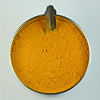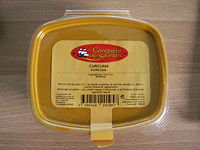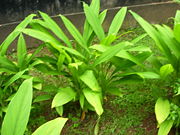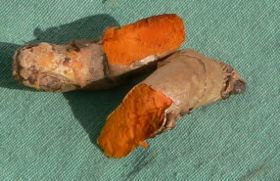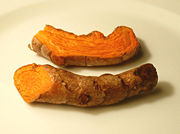Turmeric
2008/9 Schools Wikipedia Selection. Related subjects: Food; Plants
| Turmeric | ||||||||||||||||
|---|---|---|---|---|---|---|---|---|---|---|---|---|---|---|---|---|
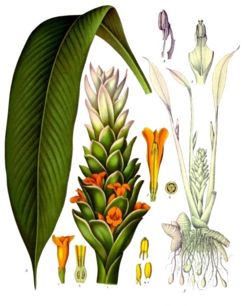 Curcuma longa
|
||||||||||||||||
| Scientific classification | ||||||||||||||||
|
||||||||||||||||
| Binomial name | ||||||||||||||||
| Curcuma longa Linnaeus |
Turmeric ( Curcuma longa) is a rhizomatous herbaceous perennial plant of the ginger family, Zingiberaceae which is native to tropical South Asia. It needs temperatures between 20 and 30 deg. C. and a considerable amount of annual rainfall to thrive. Plants are gathered annually for their rhizomes, and re-seeded from some of those rhizomes in the following season.
It is also often misspelled (or pronounced) as tumeric. It is also known as kunyit (Indonesian and Malay) or haldi or pasupu in some Asian countries. In medieval Europe, turmeric became known as Indian Saffron, since it is widely used as an alternative to far more expensive saffron spice.
Its rhizomes are boiled for several hours and then dried in hot ovens, after which they are ground into a deep orange- yellow powder commonly used as a spice in curries and other South Asian cuisine, for dyeing, and to impart colour to mustard condiments. Its active ingredient is curcumin and it has an earthy, bitter, peppery flavor and has a mustardy smell.
Sangli, a town in the southern part of the Indian state of Maharashtra, is the largest and most important trading centre for turmeric in Asia or perhaps in the entire world.
Uses
Food
In non-Indian recipes, turmeric is sometimes used as a coloring agent. It has found application in canned beverages, baked products, dairy products, ice cream, yogurt, yellow cakes orange juice, biscuits, popcorn-colour, sweets, cake icings, cereals, sauces, gelatins, etc. It is a significant ingredient in most commercial curry powders.
Turmeric (coded as E100 when used as a food additive) is used to protect food products from sunlight. The oleoresin is used for oil-containing products. The curcumin/ polysorbate solution or curcumin powder dissolved in alcohol is used for water containing products. Over-coloring, such as in pickles, relishes and mustard, is sometimes used to compensate for fading.
In combination with annatto (E160b), turmeric has been used to colour cheeses, yogurt, dry mixes, salad dressings, winter butter and margarine. Turmeric is also used to give a yellow colour to some prepared mustards, canned chicken broths and other foods (often as a much cheaper replacement for saffron).
Turmeric is widely used as a spice in Indian and other South Asian cooking. Momos (Nepali meat dumplings), a traditional dish in South Asia, are spiced with turmeric.
Medicine
In Ayurvedic medicine, turmeric is thought to have many medicinal properties and many in India use it as a readily available antiseptic for cuts, burns and bruises. Practitioners of Ayurvedic medicine say it has fluoride which is thought to be essential for teeth. It is also used as an antibacterial agent.
It is taken in some Asian countries as a dietary supplement, which allegedly helps with stomach problems and other ailments. It is popular as a tea in Okinawa, Japan. It is currently being investigated for possible benefits in Alzheimer's disease, cancer and liver disorders.
It is only in recent years that Western scientists have increasingly recognised the medicinal properties of turmeric. According to a 2005 article in the Wall Street Journal titled, "Common Indian Spice Stirs Hope," research activity into curcumin, the active ingredient in turmeric, is exploding. Two hundred and fifty-six curcumin papers were published in the past year according to a search of the U.S. National Library of Medicine. Supplement sales have increased 35% from 2004, and the U.S. National Institutes of Health has four clinical trials underway to study curcumin treatment for pancreatic cancer, multiple myeloma, Alzheimer's, and colorectal cancer.
A 2004 UCLA-Veterans Affairs study involving genetically altered mice suggests that curcumin, the active ingredient in turmeric, might inhibit the accumulation of destructive beta amyloids in the brains of Alzheimer's disease patients and also break up existing plaques. "Curcumin has been used for thousands of years as a safe anti-inflammatory in a variety of ailments as part of Indian traditional medicine," Gregory Cole, Professor of medicine and neurology at the David Geffen School of Medicine at UCLA said.
Another 2004 study conducted at Yale University involved oral administration of curcumin to mice homozygous for the most common allele implicated in cystic fibrosis. Treatment with curcumin restored physiologically-relevant levels of protein function.
Anti-tumoral effects against melanoma cells have been demonstrated.
A recent study involving mice has shown that turmeric slows the spread of breast cancer into lungs and other body parts. Turmeric also enhances the effect of taxol in reducing metastasis of breast cancer.
Curcumin is thought to be a powerful antinociceptive (pain-relieving) agent. In the November 2006 issue of Arthritis & Rheumatism, a study was published that showed the effectiveness of turmeric in the reduction of joint inflammation, and recommended clinical trials as a possible treatment for the alleviation of arthritis symptoms. It is thought to work as a natural inhibitor of the cox-2 enzyme, and has been shown effective in animal models for neuropathic pain secondary to diabetes, among others.
Presenting their findings at the Endocrine Society’s annual meeting in San Francisco in June 2008, researchers discovered that turmeric-treated mice were less susceptible to developing Type 2 diabetes, based on their blood glucose levels, and glucose and insulin tolerance tests. They also discovered that turmeric-fed obese mice showed significantly reduced inflammation in fat tissue and liver compared to controls. They speculate that curcumin in the turmeric lessens insulin resistance and prevents Type 2 diabetes in these mouse models by dampening the inflammatory response provoked by obesity.
Cosmetics
Turmeric is currently used in the formulation of some sunscreens. Turmeric paste is used by some Indian women to keep them free of superfluous hair. Turmeric paste is applied to bride and groom before marriage in some places of India, Bangladesh, and Pakistan, where it is believed turmeric gives glow to skin and keeps some harmful bacteria away from the body.
The Government of Thailand is funding a project to extract and isolate tetrahydrocurcuminoids (THC) from turmeric. THCs (not to be confused with tetrahydrocannabinol, also known as THC) are colorless compounds that might have antioxidant and skin-lightening properties and might be used to treat skin inflammations, making these compounds useful in cosmetics formulations.
Dye
Turmeric makes a poor fabric dye as it is not very lightfast (the degree to which a dye resists fading due to light exposure). However, turmeric is commonly used in Indian clothing, such as a chira.
Gardening
Turmeric can also be used to deter ants. The exact reasons why turmeric repels ants is unknown, but anecdotal evidence suggests it works.
Chemistry
Turmeric contains up to 5% essential oils and up to 3% curcumin, a polyphenol. It is the active substance of turmeric and it is also known as C.I. 75300, or Natural Yellow 3. The systematic chemical name is (1E,6E)-1,7-bis(4-hydroxy-3-methoxyphenyl)-1,6-heptadiene-3,5-dione.
It can exist at least in two tautomeric forms, keto and enol. The keto form is preferred in solid phase and the enol form in solution.
